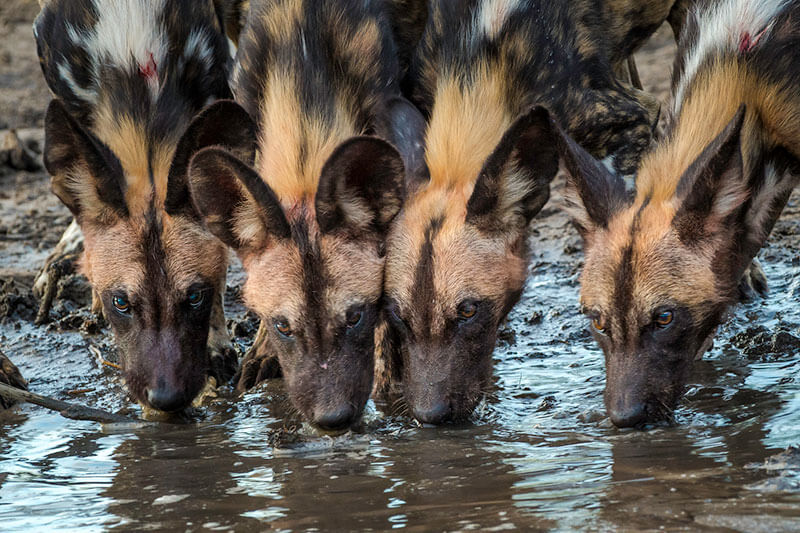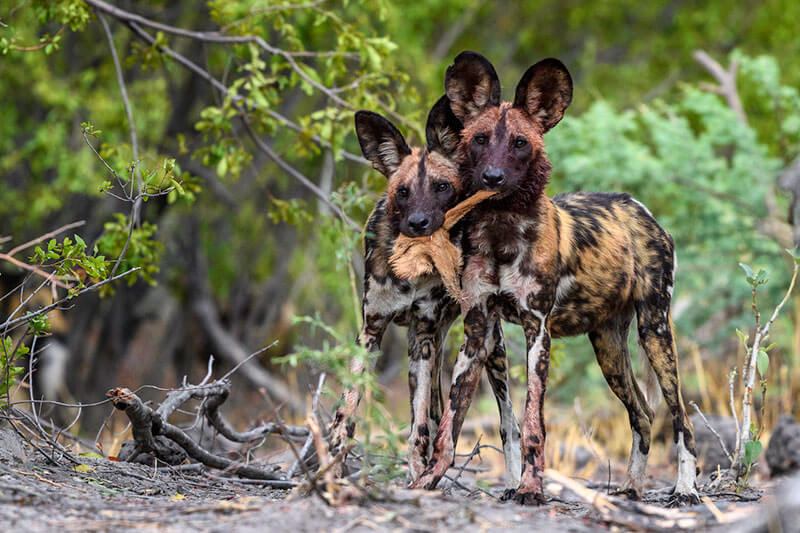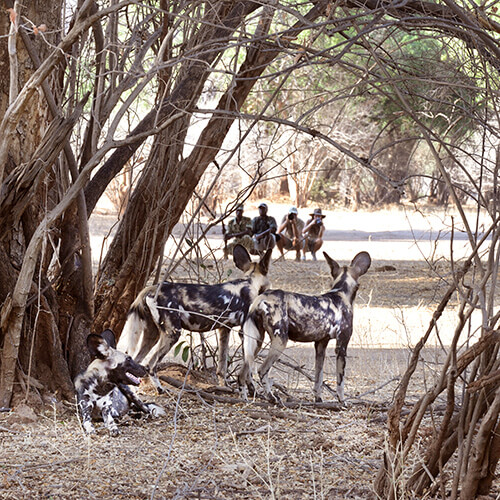There are many incredible animals to see during an African safari, but catching a glimpse of the African wild dog is one of the most precious sightings you could hope for.
Critically endangered due to human activity and habitat loss, African wild dog sightings are a rare occurrence outside of specific conservation areas.
To bring you more information on one of Africa’s lesser-known animals, we’ve compiled a list of amazing facts about the African wild dog. Be sure to look out for these incredible animals during your next safari trip to Africa.
If you love learning about animals, read our previous animal facts posts about lions and pangolins.
Interesting Facts About African Wild Dogs
In no particular order, here are a number of African wild dog facts.
They have many names
Most commonly known as the African wild dog, these pups are given many other names, including the African hunting dog, Cape hunting dog or African painted dog. The last name, the painted dog, may seem a bit unusual, but it actually refers to the scientific name of the African wild dog, “Lycaon pictus” which translates to “painted wolf.”
Painted refers to the mottled black, brown, yellow and white colouring in their fur. Each dog has a unique patterning, which helps members of the pack distinguish between one another. Their unusual colours also allow the wild dogs to blend into their natural habitat of grassland, savannah and woodland.
They have a unique social structure
African wild dogs are incredibly social animals and are constantly communicating with one another through touch, tail wags and a variety of vocalizations.
African wild dogs live in packs ranging from six to up to 30 members. There is a strict hierarchy within the pack, seeing a dominant breeding pair in charge of the group with the rest of the pack assuming roles as subordinates. Unlike many other species in the animal kingdom, once the African wild dogs reach maturity, it is the males that stay within their natal pack while females migrate and join new packs.
They protect one another
African Wild dogs have incredible relationship values. They rarely intimidate or battle one another for dominant positions, instead, they display behaviours that support the health of the pack over the individual.
For example, young cubs are raised and protected by all members of the pack, both male and female. When feeding, the young cubs take priority over the kill – even over the Alpha pair – while the rest of the members wait for the cubs to finish.
When feeding, they share the kill, even with members who weren’t involved in the actual hunt. Another example is when a dog becomes ill, injured or elderly, restricting them from hunting, the rest of the pack cares for and feeds them while they return to better health.
They are nomads
Wanderers, that rarely stay in one place for long, African wild dogs are nomadic and require large territories to thrive. They can travel 50 km in a single day and their territories can range between 400 and 1500 square kilometres. The only time wild dogs remain in one area is when they are denning.
They are agile hunters
Built for high stamina chases, the African wild dogs are swift, agile hunters that can endure long-distance chases to wear down their prey. Working flawlessly as a team, the pack is well coordinated during a hunt.
The typical hunt will involve the dogs finding prey (various antelope, often impala, kudu, gazelles, springbok and wildebeest) and spreading out in line to cover a larger space. The wild dogs will immediately approach and test the animal’s defences, at which a chase will take place. As the dog at the head of the chase tires and falls back, another wild dog takes over, relentlessly keeping the hunt alive. Eventually, after a few kilometres, the prey becomes exhausted and falls victim to the pack’s high endurance and teamwork.
Their stamina combined with tactical hunting methods and flawless teamwork leads to an 80% success rate in hunts.
They have hunting rituals
African Wild dogs are highly intelligent animals and are in constant communication with each other. They have a coordinated social structure which allows their pack to work together and successfully hunt together.
Before a hunt, the dogs have a playful ceremony in which they bond and initiate each hunt. The dogs start circulating among each other, touching and vocalising until they get excited and are ready to hunt. While hunting, the dogs let one another know their location and the location of the prey.
African wild dogs are most active during twilight
During the time immediately before dawn and after dusk, twilight is a key opportunity for wild dogs as their prey is the most active during this period. The cover of night gives the wild dogs camouflage advantage for hunting, making them more difficult to be detected by both predators and prey.
The African wild dog is endangered
The African wild dog is currently the second most endangered canine in Africa after the Ethiopian Wolf. Populations of African wild dogs was once estimated to be as high as 500,000 but are now down to just over 5000 adults. This massive population decrease is largely due to human involvement in wild dog territory and loss of habitat.
In previous years, African wild dogs were considered to be pests, and farmers would shoot them down, track their dens and poison the inhabitants inside. As well as farmers, poachers’ snares would also contribute to the decline of the wild dog population. In the wild, lions are the dog’s main predator, while diseases such as rabies contracted from domesticated animals is also a major threat.
The Difference between Hyenas and Wild Dogs
African wild dogs are commonly mistaken for hyenas, but in fact, there are many differences, both physically and behaviorally, between these two beautiful animal species.
Hyenas have a larger build with spotted markings, while African wild dogs are smaller and more slender in shape, and have mottled marked fur. African wild dogs also have large round ears.
Hyenas are scavengers while wild dogs are hunters. Hyenas will never pursue a kill, unless desperate, instead, they’ll wait around for other predatory animals to tire from a kill, and scavenge and steal the carcass remains. Wild dogs, on the other hand, are very active hunters that work as a pack to secure a kill.
As scavengers, hyenas are more competitive over food sources and spend a lot of their time fighting with each other. Wild dogs are team players and tend to care more about the well-being of the pack rather than the individual dominance, thus, sharing food resources and caring for ill or injured pack members is common.
While African wild dogs belong to the family Canidae (canines), hyenas are not dogs but are closer related to mongooses and cats!
Now that you know more about the African wild dog, book a safari in Africa to catch a sighting of these incredible animals in the wild! African wild dog populations can often be seen in South Africa’s Kruger national Park and on safari in Botswana!
We want to hear from you!
Did you enjoy reading about the amazing African wild dogs? Have you seen these incredible pups in the wild? Share your experience of seeing an African wild dog on safari in the comments section below! We love reading your feedback! Thanks for reading.









this is very informational and i enjoyed it very much
Thanks for the info. I watch Savage kingdom on National Geographic wild channel and was curious about the different species. Now I know why the lions and them don’t get along.
Lions and Hyenas are both carnivorous! And are killer from two different world!!! So you would always except a fight among the two
very decinent facts and right becuse back in africa I saw one he has the exact same things thank you
thankyou this was very informative
MY BABY!!!!!!!! I want one of both! Baby painted wild dog and baby hyena. SOOOOOOOOOOO Adorable! 😀
Hyena are excellent voracious hunters. They are not purely scavengers and quite often will hunt on their own. However they wont pass up on an easy meal. You should edit that they will never pursue a kill because that is not true.
it really helped on a high school paper